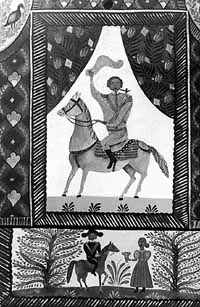Undesirable Witnesses

Old-time portraits are said to possess a wonderful ability to fixate the viewer, turning the enchantingly painted eyes in any direction the viewer goes. Svitlana Derenchuk’s characters do also. The way they look is the first impression her pictures create: no sooner have you found your bearings than you feel a certain intuitive and subconscious sensation that they are looking right through you with their piercing eyes. But after all, they are looking somewhere faraway or perhaps just gazing blankly — but, in any case, not at the spectator. The onlooker is nothing but an almost accidental (and sometimes an obviously undesirable) witness, just a passerby.
***
Here spectators are in general not considered. Nobody stoops to explaining his/her actions. If you want to see, please do so. If you want to find your way about, be my guest. And your intense delight seems to be mixed with embarrassment. Sometimes a spectator finds him or herself right in the skin of a Marquez heroine who saw what she should not have seen: as is known, she was punished for this by having her head cut off every night for 150 years. Moreover, the deliberate simplicity of titles and the seemingly innocent plots of pictures are a logical and natural part of all that is going on.
An elderly prioress angling in the shade of some exotic fruit trees against the background of a flaming sky (The Prioress); two little orphans strolling around the garden, supervised by a nun sporting a winged toque (Orphanage); a rustic fellow running his fingers over an ax blade, unaware of the dripping blood (Fellow Lost in Thought). Indeed, there is nothing unclear, let alone supernatural, in this. But there is something else. What is it?
A special harmony reigns over the world of Svitlana Derenchuk. What is typical of the artist’s heroines is the state of somewhat detached, almost somnolent peace. Yet, sometimes their faces scowl in deep and indescribable horror and mouths burst open, crying out at the top of the human voice. The causes and ends are still unimportant: this piece is just about shouting, as the other is about an angling prioress.
This is a self-sufficient or in other words untranslatable world. All you are looking for is in precisely this world: in paintings, graphics, painted- over boards, cloth tapestries, and dolls.
***
It is next to impossible to adjust Ms. Derenchuk’s works to any standards. The few facts that seem to be able to confirm one theory or another deny each other with surprising consistency. The artist took part in a Kyiv exhibition, The Limits of the Primitive: so is her art primitive? Svitlana Derenchuk’s personal exhibition was held in the Kyiv Pecherska Lavra’s Museum of Decorative Folk Art: does this mean she is a folk artist? Her painted-over wooden boards (only boards!) resemble, according to connoisseurs, Russian folk pictures of the seventeenth and eighteenth centuries: then is this stylization? But, by all accounts, these inquiries only make it clear that Ms. Derenchuk represent none of these schools. She is on her own. The artist’s world is her own creation from beginning to end.
***
It is not only useless but even unethical to seek the explanation of Ms. Derenchuk’s world in certain facts of her life story. It will be more reasonable — to make things completely clear — to confine ourselves to a sort of resume.
So she was born in Mariupol in 1972. In 1988-1991 she attended a Mariupol fine arts studio run by artist Volodymyr Miski-Ohlu. This seems to have been a period of not so much practice as of theory, not so much of independent creative work as of creative soul-searching. In 1991-1997 she worked at artist Tetiana Lysenko’s studio, which was beyond doubt a time of professional training. 1991 was the year of her turning point. The issue is not only in exhibitions that reach Paris a year later (still, the artist’s most comprehensive personal exhibition was held in Kyiv, at the Lavra’s Museum of Decorative Folk Art, in 1997). It is more important that Svitlana Derenchuk herself considers 1991 as the point of departure for her creative work.
Nonetheless, even such a terse and highly condensed biography of the artist is expressive in its own way. It shows the road of an individual who made all personal decisions surprisingly early in her life, who managed to catch the sense of her existence when she was still in high school






